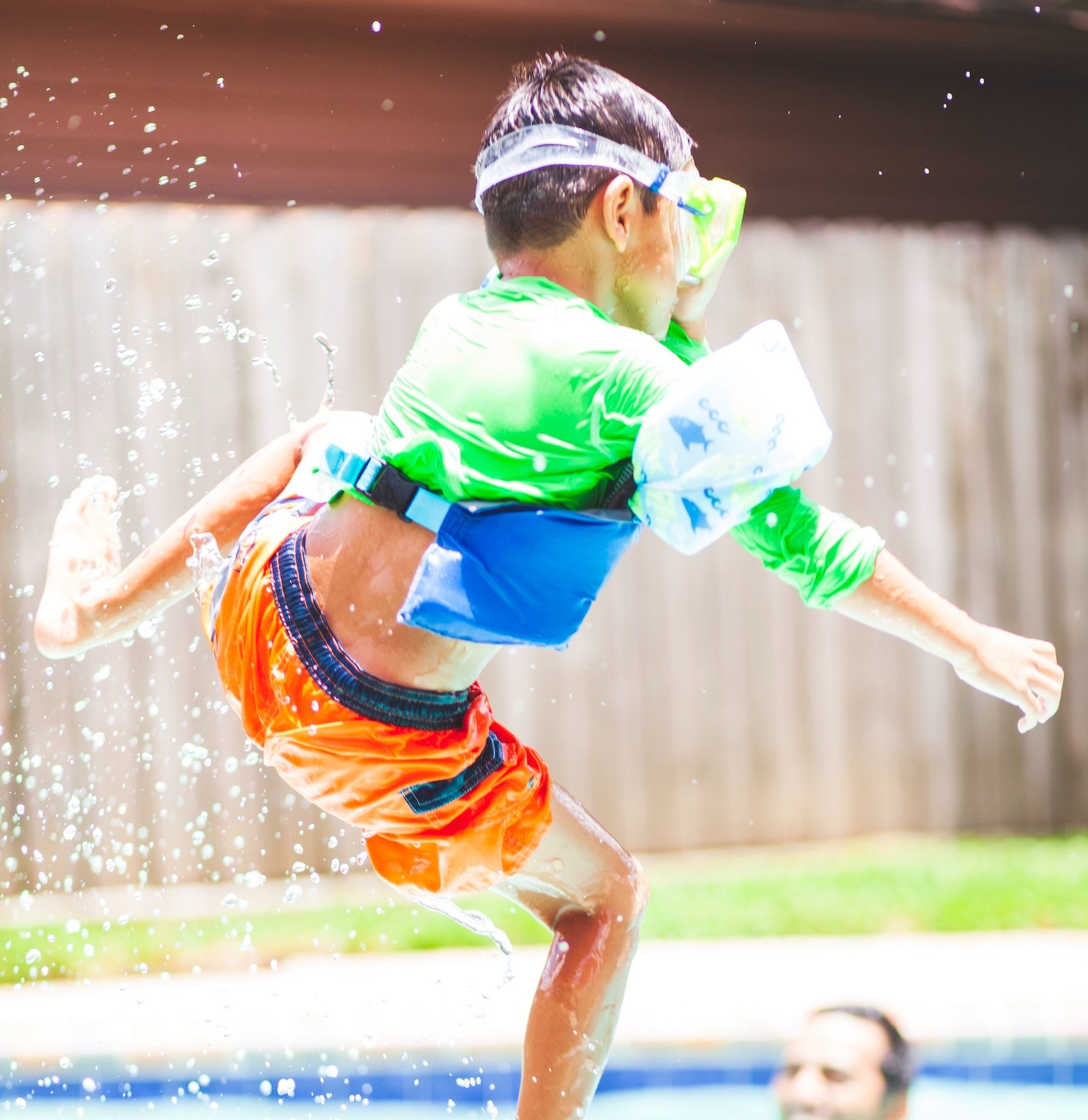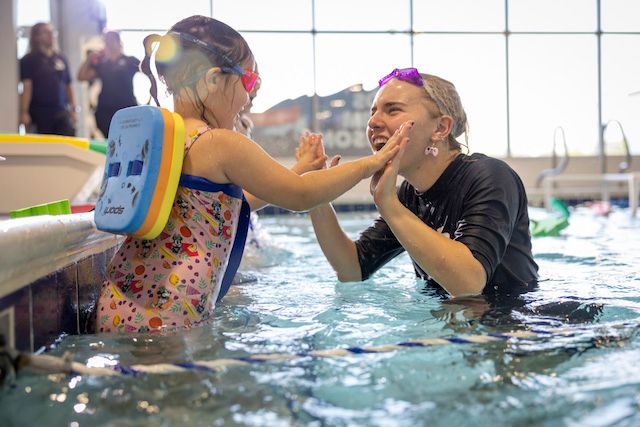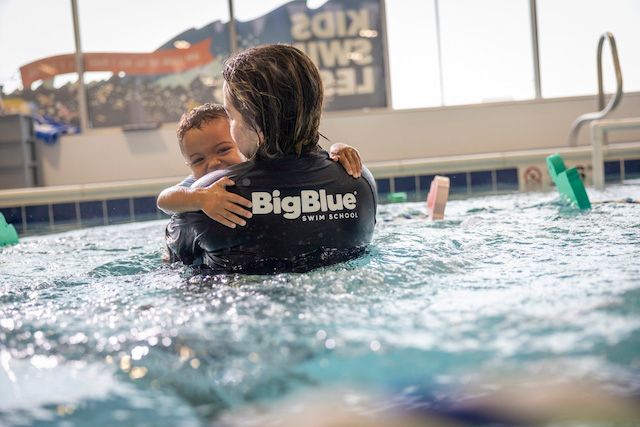Safer Swimming: Flotation Devices and More
Parents of growing children spend time each spring seeing what swimsuits still fit, looking for goggles, and ensuring the sunscreen hasn't expired. If you have newer swimmers, this is also a great time to check that you have the correct flotation devices for activities around the water, ranging from the pool to being out on a boat.
At Big Blue Swim School, we prioritize health, safety, and fun in every swim lesson. Today, we’ll provide more information on the best swim floaties for toddlers, the safest swim floaties for toddlers, and other swimming aids to ensure your little ones are well-prepared and safe.
Why Water Safety Matters
Water activities can be a fun and exciting way for your children to stay active, but it’s crucial to understand the importance of water safety. Every year, countless families are affected by water-related accidents, many of which could be prevented with proper precautions and the use of floatation devices.
Your child may need a personal flotation device when near water, like a pool or beach. Factors like your child's swim skills and comfort level around water, the activities, and the supervision available may help you decide if a floatation device is necessary. Remember, a flotation device is never a substitute for adult supervision.
Drowning is the leading cause of death for children ages 1-4 and the second leading cause of death for children ages 5-14. In 2021, 83% of boat-related drowning deaths reported by the U.S. Coast Guard involved individuals not wearing life jackets. These statistics highlight the crucial role of swim floaties, life jackets, and other swimming aids in preventing accidents.
Regardless of age or swim skill, your child must always wear a life jacket on a boat. State laws will vary, but in general, any child younger than 13 who is above deck on a moving boat must wear a U.S. Coast Guard-approved life jacket. In fact, you will want to be sure you have a life jacket for each person on a boat, out of the packaging and ready for use.

Types of Flotation Devices
When it comes to water safety, choosing a suitable flotation device for your child is essential.
Overview of Flotation Devices
Flotation devices are tools designed to help individuals stay afloat in the water, providing essential support and buoyancy. These devices are crucial for water safety, especially for children and inexperienced swimmers. The most common types of flotation devices include:
- Life jackets: Full-body devices that provide significant buoyancy and are typically used in open water and boating activities
- Swim vests: Lighter than life jackets, these vests offer buoyancy and freedom of movement for swimming
- Swim floaties: Inflatable or foam bands worn around the arms to keep the upper body afloat
- Pool noodles: Versatile foam tubes used for support and fun in the water.
- Kickboards: Flat, buoyant boards used to support the upper body while focusing on kicking techniques
Choosing the right flotation device for your child to ensure their safety and comfort is essential. The right device ensures proper support, encourages confidence in the water, and enhances the overall swimming experience. Consider your child’s swimming skills and the specific water activities they’ll be engaging in when selecting a flotation device.
Remember, swim floaties, tubes, and pool noodles do not prevent drowning and should never be used as a substitute for a life jacket. These devices can be used in addition to life jackets, but they should not solely be relied upon for safety.

Swim Floaties
Swim floaties are inflatable or foam armbands designed to support children in the water. These devices are typically worn around the upper arms, helping to keep the child’s head above water and provide extra stability. The most common types of swim floaties include:
- Inflatable arm bands: These are adjustable and can be easily inflated to fit snugly around the arms
- Foam arm bands: These provide constant buoyancy without needing to be inflated
- Combination floaties: These include designs that combine arm bands with a chest piece for added support and stability
Pros and Cons of Using Swim Floaties
Pros:
- Simple to use and adjust
- Offer good buoyancy and support
- Lightweight and easy to carry
Cons:
- May provide a false sense of security
- Can limit arm movement
- Not a replacement for adult supervision or a life jacket
Swimming Aids
Swimming aids are devices designed to assist in learning how to swim and improving swimming skills. These aids come in various forms and are used to build confidence and techniques in the water. The most common types of swimming aids include:
- Kickboards: Flat, buoyant boards that help swimmers focus on leg movements and kicking techniques
- Swim vests: Lightweight vests that provide buoyancy while allowing for a full range of motion
- Pool noodles: Versatile foam tubes used for support, balance, and fun activities in the water
- Swim belts: Belts with attached floats that help maintain buoyancy while swimming
While swim floaties are primarily designed to keep a child’s upper body afloat, swimming aids serve a broader purpose. Swim floaties are typically used for essential buoyancy, whereas swimming aids are used to teach specific swimming skills and techniques.
Using swimming aids in conjunction with swim floaties can enhance the learning experience for young swimmers, aid children in building confidence in the water, and help them develop and hone proper swimming techniques.

The Best Swim Floaties for Toddlers
When it comes to keeping your little ones safe in the water, choosing the right swim floaties is crucial. Here are the top features to look for when selecting the best swim floaties for toddlers:
Top Features to Look For
- Safety certifications: Ensure the floaties are certified by safety organizations like the U.S. Coast Guard or the American Society for Testing and Materials (ASTM)
- Adjustability: Look for floaties with adjustable straps to ensure a snug and secure fit as your child grows
- Comfort: Soft, non-chafing materials and ergonomic designs that allow for natural movement
- Buoyancy: Adequate buoyancy to keep your child’s head above water without causing discomfort
- Durability: High-quality materials that can withstand regular use and exposure to water and sunlight
- Visibility: Bright colors and reflective elements make it easier to spot your child in the water
- Ease of use: Floaties that are easy to put on and take off, even when wet
Choosing the safest swim floaties for toddlers with these features ensures your child remains safe and comfortable while they learn to swim.
The Safest Swim Floaties for Toddlers
Safety Considerations
When selecting the safest swim floaties for toddlers, several key factors must be considered to ensure optimal comfort and safety, including:
Proper Fit and Size
Proper fit is crucial for safety. Floaties should fit snugly but comfortably around your child’s arms. Floaties with adjustable straps can also help ensure the right fit as your child grows. Check the weight limits—both minimums and maximums—for the device since kids keep growing, or a younger sibling may weigh more or less than their siblings at the same age.
Material and Durability
Choose swim floaties made from high-quality, durable materials that withstand wear and tear. Materials should be non-toxic and safe for prolonged skin contact. Look for puncture-resistant materials with strong seams to prevent leaks. UV-resistant materials are also a good choice to ensure floaties last longer, even with regular sunlight exposure.
Design Features that Enhance Safety
Look for design features that offer additional safety measures, such as:
- Dual chambers: Floaties with dual air chambers provide extra security if one chamber deflates.
- Non-slip inner surfaces: These help keep the floaties securely in place on your child’s arms, preventing them from sliding off.
- Bright colors and reflective elements: High visibility in the water ensures you can easily spot your child.
- Safety valves: Valves that prevent accidental deflation ensure the floaties remain inflated during use.

Safety Tips for Parents
In addition to selecting the safest swim floaties for toddlers, here are some safety tips to help keep your child safe during water activities:
- Supervision and vigilance: Never rely solely on swim floaties to keep your child safe. Always supervise your child closely when they are in or near water.
- Regularly check and maintain flotation devices: Inspect flotation devices regularly for signs of wear, damage, or deflation. Replace them immediately if they show any signs of compromise.
- Educate children on water safety: Teach them the basics of water safety, including not going near water without an adult and how to float on their back. This education, combined with the use of swimming aids and swimming lessons, helps build confidence and safety awareness.
Make a Splash with Big Blue Swim School: Enroll in Swim Lessons Today!
Want to get started with the best and safest swimming experience for your child? We can't wait to meet you and your little swimmer! At Big Blue Swim School, we recommend the best swim floaties for toddlers and provide top-notch swim lessons to ensure your child’s safety and confidence in the water.
Simply, find a Big Blue Swim School location near you to enroll in swim lessons. We can't wait to help your family embark on a fun and secure swimming journey with us today!

Frequently Asked Questions
What Is the Best Flotation Device for Toddlers?
The best flotation device for toddlers is a U.S. Coast Guard-approved life jacket that fits snugly and comfortably. Look for approved life jackets with non-toxic materials, adjustable straps, and bright colors for visibility.
Are Swim Floaties Safe for Toddlers?
Swim floaties can be safe when used correctly and under adult supervision. They provide buoyancy but should never replace a life jacket or constant supervision.
How Do I Choose the Right Size Swim Floaties for My Child?
Choose swim floaties that fit snuggly around your child’s upper arms without being too tight. Adjustable straps are ideal for ensuring a secure and comfortable fit.
Can Swim Floaties Be Used for Swim Lessons?
Yes, swim floaties can be used during swim lessons to provide extra buoyancy and confidence.
How Should I Maintain and Care for Flotation Devices?
Regularly inspect all flotation devices for signs of damage, deflation, or wear. Rinse with fresh water after use, dry thoroughly, and store in a cool, dry place.
What Other Swimming Aids Can Be Used Alongside Swim Floaties?
Kickboards, swim vests, pool noodles, and swim belts can be used alongside swim floaties to enhance safety and aid children in learning swimming techniques.
How Do I Teach My Toddler to Be Safe in the Water?
Teach your toddler basic water safety rules like never going near water without an adult. You can also enroll your child in swim lessons and practice floating and swimming techniques. Remember, always supervise closely during water activities.